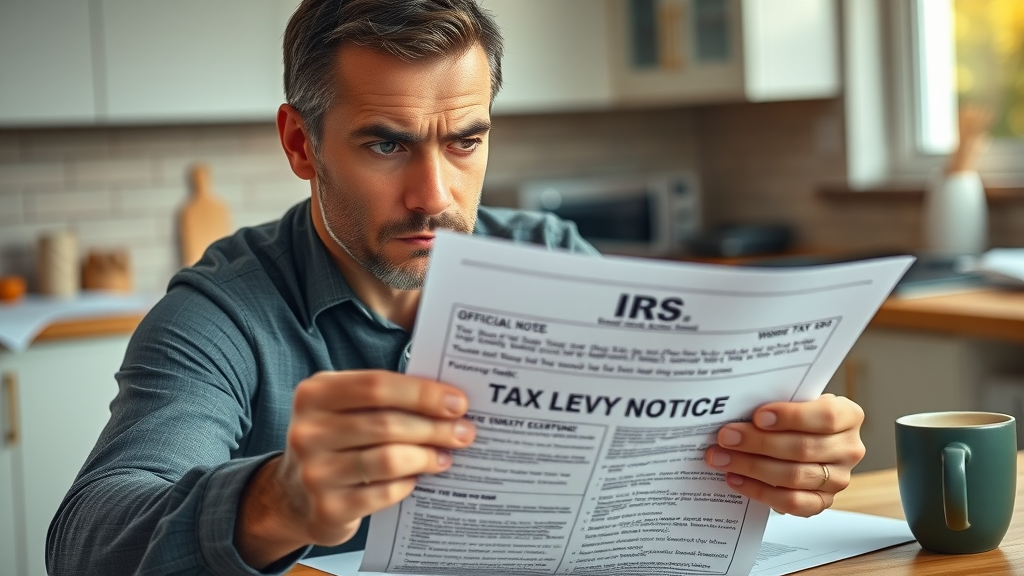Did you know the IRS issues millions of tax levies each year? If you’ve received a notice about a tax levy, you’re not alone—and you can’t afford to ignore it. Tax levies can lead to the direct seizure of your wages, bank accounts, or other assets, causing serious financial hardship. But understanding your rights and the steps you need to take can protect your property and put you on the path to resolution. This guide will arm you with must-know facts, practical strategies, and expert advice to address a tax levy head-on and potentially stop IRS collection actions before they go too far.
Startling Facts: Why You Can’t Ignore a Tax Levy
The reality is that when it comes to a tax levy, time is not on your side. Each year, the Internal Revenue Service (IRS) aggressively pursues unpaid tax debts through levy actions because it’s the most effective method to satisfy a tax liability. According to recent IRS data, millions of wage levies and bank account seizures occur annually, disrupting financial stability for taxpayers nationwide. Unlike a tax lien, which is a legal claim against your property, a tax levy is an immediate legal seizure of your assets—such as paycheck garnishments or frozen bank accounts—to collect on unpaid federal tax.
Ignoring an IRS levy notice is the fastest route to financial trouble. The impact isn’t limited to your bank balance; it can bring added stress, harm your credit, and jeopardize assets you may rely on. Even if you think you can resolve the tax debt later, once a final notice of intent is issued, your window for a simple fix quickly closes. Acting quickly and understanding the IRS process can make the difference between controlling the outcome or losing options entirely.
"Each year, the IRS issues millions of tax levies—don’t become another statistic."
What You'll Learn About Tax Levy Notices
- What a tax levy is and how it differs from a tax lien
- Types of IRS levy actions, including wage levies
- Steps to take immediately after receiving an IRS tax levy notice
- Effective ways to stop or remove a tax levy
- Expert tips on communicating with the Internal Revenue Service
Understanding a Tax Levy: IRS Levy Defined

What is a Tax Levy?
- Definition of tax levy
- Differences: tax levy vs. tax lien
- How the IRS initiates an IRS levy
A tax levy is the IRS’s most forceful collection tool—a legal seizure of your property to pay off a tax debt. Unlike a tax lien, which merely places a legal claim on your property as security for unpaid taxes, a levy lets the IRS actually take property—including money held in bank accounts, a portion of your paycheck (wage levies), and even assets like cars or real estate. When the Internal Revenue Service determines that you haven’t responded to collection notices regarding an unpaid income tax or other federal tax liabilities, it can initiate a levy action after sending a final notice of intent to levy and notice of your right to a hearing. This process is regulated by the Internal Revenue Code, and all actions are strictly managed through official IRS channels—often starting with a notice of levy sent by certified mail.
The distinction from a tax lien is critical: a lien marks a debt on your record and hampers your ability to transfer or sell property; a levy actually takes your money or property to satisfy a tax. If you have received a notice of intent to levy or a final notice, it means the IRS intends to take swift action. Review all IRS correspondence promptly and understand your options, as the IRS has the legal backing to enforce these actions across the United States—even when you least expect it.
People Also Ask: What is a tax levy?
Answer: A tax levy is a legal seizure of your property to satisfy a tax debt. The IRS can levy assets such as wages, bank accounts, and more until your tax debt is paid.
Types of IRS Tax Levy: Wage Levies, Bank Levies, and More
- Wage levies – how the IRS garnishes paychecks
- Bank account and property levies
- IRS tax lien differences and implications
- Unemployment and retirement account levies
The IRS uses several types of levy actions to collect on unpaid federal tax. The most common are wage levies, where a portion of your paycheck is redirected straight to the Internal Revenue Service. Your employer is required, by IRS code section, to comply with this order. Only a specific exempt amount—based on your filing status and number of dependents from IRS Publication 1494—can be protected, making wage levies a particularly disruptive form of debt collection.
Another major form of IRS levy is the bank account levy. Here, the IRS freezes and then withdraws funds directly from your bank or financial accounts, leaving you with little room for negotiation once the process is set in motion. The IRS may also levy other assets such as real estate, vehicles, or even cash value in life insurance policies. While a tax lien is a public notice indicating the government’s legal claim, a levy actually removes the asset or funds to satisfy a tax liability. If you’re unemployed, or receive retirement or Social Security benefits, the IRS can also levy some of these payments, though limits may apply.
People Also Ask: What is a Wisconsin tax levy?
Answer: A Wisconsin tax levy is an enforcement action by the state's Department of Revenue, similar to an IRS levy, allowing the state to collect back taxes directly from wages or assets.
Why Did I Get a Tax Levy Notice from the Internal Revenue Service?
- Common triggers for IRS levy notices
- IRS collection process: Notices and warnings
- The role of the internal revenue system in tax enforcement
Receiving a tax levy notice from the IRS means you’ve reached a critical point in the IRS tax collection process. Common triggers include failing to file a required tax return, owing a significant outstanding federal tax debt, or ignoring previous IRS notices and warnings. The process unfolds in several stages: after determining you owe taxes, the IRS will send multiple letters—beginning with reminders and escalating to a final notice of intent to levy. Only after these steps and insufficient response will the levy action commence.
The IRS operates under the authority of the Internal Revenue Code to enforce compliance and recover unpaid taxes for the United States government. Notices often reference the intent to levy or a specific code section authorizing collection. If you’ve received a notice of levy, consult the gov website or a tax professional to verify the debt’s validity and begin mounting a response. Acting quickly is essential because additional delays can result in wage levies or bank account seizures within as little as 30 days of the final notice.
People Also Ask: Is a tax levy good or bad?
Answer: A tax levy is generally considered bad, as it means the IRS is actively collecting on unpaid tax debts—often resulting in financial hardship and credit damage.
Immediate Steps to Take After Receiving an IRS Tax Levy Notice
- Read the IRS tax levy notice thoroughly
- Confirm the validity of your tax debt
- Contact the IRS or a qualified tax professional promptly
- Gather financial documentation regarding the tax debt and your assets
- Respond before the IRS levy deadline
Your response timeline is critical. As soon as you receive an IRS tax levy notice, carefully read it to understand the specifics of your tax liability and the actions the IRS intends to take. Confirm whether the tax debt cited is accurate—sometimes tax returns are processed with errors, or payments may not have been properly credited. If unsure about the validity, use the official website of the IRS or consult directly with the agency.
Next, immediately contact the IRS or engage a trusted tax professional. Provide all relevant information, including prior tax return filings, wage statements, and previous IRS correspondence. Quick and thorough communication can sometimes delay or even suspend levy actions. Be sure to assemble documentation about your finances—including bank account statements, pay stubs, and evidence of hardship. Importantly, always respond before the official deadline—typically shown clearly in your notice—to preserve your appeal rights and possible collection alternatives.

How to Stop a Tax Levy: Strategies and IRS Relief Options
- Request a Collection Due Process hearing
- Settle your tax debt or negotiate a payment plan
- Apply for an Offer in Compromise
- File for innocent spouse relief (if applicable)
- Seek professional tax help for IRS levy relief
Stopping a tax levy requires prompt action and a clear understanding of IRS procedures. One of the first options is to request a Collection Due Process (CDP) hearing within 30 days of your final notice of intent. This legal right pauses IRS levy actions until your case is reviewed. Alternatively, you can contact the IRS to set up an installment agreement or another payment plan—demonstrating your intention to resolve your tax liability.
Taxpayers who cannot pay the full balance may qualify for an Offer in Compromise (OIC), which allows you to settle the IRS tax debt for less than the full amount. Special provisions, such as innocent spouse relief, may apply if your tax liability arose from a spouse’s error or fraud. Each option comes with eligibility criteria and documentation demands, so fast, professional guidance is paramount. Expert tax professionals can negotiate directly with the Internal Revenue Service and ensure all forms and appeals are properly handled to maximize your relief potential.
People Also Ask: How much can the IRS levy from your paycheck?
Answer: The IRS can levy most of your paycheck—except for certain exempt amounts which vary based on dependents and filing status. Consult IRS Publication 1494 for specifics.
Tax Levy vs. Tax Lien: Key Differences Explained
| Aspect | Tax Levy | Tax Lien |
|---|---|---|
| What is it? | Seizure of property to satisfy tax debt | Claim on property as security for tax debt |
| Initiated When? | Debt is unpaid after repeated notices | After a tax debt arises |
| Can impact wages? | Yes | No |
| Affects credit score? | Indirectly | Yes, directly |
Many taxpayers confuse a tax levy with a tax lien, but understanding the difference is vital when managing a federal tax problem. A tax lien is a legal claim—or public notice—placed by the IRS on your assets to ensure payment of a tax liability. It alerts creditors and makes it difficult to sell or refinance property. In contrast, a tax levy is the actual legal seizure of your property—such as wage levies, bank account levies, or asset seizures. While both impact your finances, only a lien directly hits your credit score, and only a levy removes money or property from your control to satisfy a tax debt.
Expert Advice: Avoiding and Resolving IRS Tax Levies
"Don’t wait to act if you receive a tax levy notice. Fast action is your best defense against IRS collection." — IRS Tax Specialist
According to seasoned tax advisors, maintaining regular communication with the IRS is the best way to avoid levy action. File your tax return on time, respond promptly to all IRS tax correspondence, and consider enrolling in a payment plan if you cannot pay your debt in full. If you receive a final notice of intent to levy, don’t panic—seek professional guidance immediately. The Internal Revenue Service does provide various options for qualified individuals, but delay increases the risk of wage levies, asset seizure, and further financial complications. Stay proactive, keep records of all interactions, and use all appeal rights granted by the IRS revenue code.
If you find yourself overwhelmed by letters, levy and notice paperwork, or unfamiliar collection actions, know that expert help is available. Tax professionals can quickly assess your situation, intervene on your behalf, and identify the fastest path to relief—protecting both your current income and long-term financial future.
Frequently Asked Questions About Tax Levy
-
Can an IRS tax levy be reversed after it begins?
Yes, you may be able to reverse a tax levy if you prove financial hardship or resolve your tax debt. The IRS can release a levy if you pay your tax liability, enter into an installment agreement, or demonstrate that the levy is creating severe economic hardship. Contact the IRS or a tax professional immediately to discuss your situation and all available options. -
How long does it take to lift a wage levy?
After negotiating relief or setting up a payment plan, the IRS can lift a wage levy in as little as a few business days. The exact timeline depends on your responsiveness and whether you submit all required documentation promptly. Always follow up to confirm the levy has been officially released. -
Is my property at risk with a tax lien or tax levy?
Yes. With a tax lien, your property cannot easily be sold or refinanced. With a tax levy, the IRS can directly seize money from your bank account or garnish wages. Both actions put your assets at risk, but levies result in actual loss, while liens restrict asset transfer and can damage your credit standing.
Key Takeaways: Stop a Tax Levy Before It Starts
- A tax levy is a serious IRS collection action
- Immediate response is required to avoid financial loss
- Relief options are available for qualified taxpayers
- Tax liens differ from tax levies—both can impact your finances
Conclusion: Don’t Ignore a Tax Levy Notice
Protect your assets and rights—seek professional help immediately
The sooner you act, the better your chances of stopping or removing an IRS tax levy and regaining control over your financial life.
Have you received a letter from the IRS? Call us today at (479) 926-1040
Watch: Understanding Your IRS Tax Levy Notice (Video Resource)
Understanding Your IRS Tax Levy Notice – Video explanation on what to look for after receiving a tax levy notice, including expert tips and steps to resolve your situation.
Watch: How to Stop IRS Wage Levies (Video Tutorial)
If you’ve received a notice about a tax levy, it’s crucial to understand your rights and the steps you can take to address the situation. The IRS provides detailed information on what a levy entails and the actions required before one is issued. For a comprehensive overview, refer to the IRS’s official page: What is a levy?.
To prevent a levy, the IRS outlines proactive measures you can take, such as filing returns on time and paying taxes when due. If you’re unable to pay the full amount, it’s important to communicate with the IRS to explore payment options. Detailed guidance is available here: How do I avoid a levy?.
Understanding the difference between a tax levy and a tax lien is also essential. While a lien is a legal claim against your property to secure payment of a tax debt, a levy actually seizes your property to satisfy the debt. The IRS explains this distinction further: What’s the difference between a levy and a lien?.
If you’re serious about resolving your tax issues, these resources will provide you with the necessary information to take informed action.
 Add Row
Add Row  Add
Add 



Write A Comment